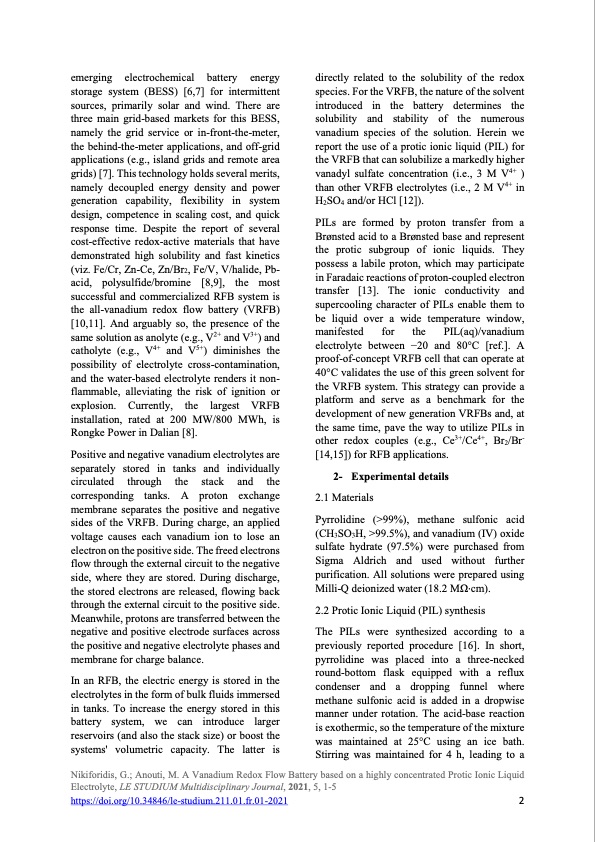
PDF Publication Title:
Text from PDF Page: 002
emerging electrochemical battery energy storage system (BESS) [6,7] for intermittent sources, primarily solar and wind. There are three main grid-based markets for this BESS, namely the grid service or in-front-the-meter, the behind-the-meter applications, and off-grid applications (e.g., island grids and remote area grids) [7]. This technology holds several merits, namely decoupled energy density and power generation capability, flexibility in system design, competence in scaling cost, and quick response time. Despite the report of several cost-effective redox-active materials that have demonstrated high solubility and fast kinetics (viz. Fe/Cr, Zn-Ce, Zn/Br2, Fe/V, V/halide, Pb- acid, polysulfide/bromine [8,9], the most successful and commercialized RFB system is the all-vanadium redox flow battery (VRFB) [10,11]. And arguably so, the presence of the same solution as anolyte (e.g., V2+ and V3+) and catholyte (e.g., V4+ and V5+) diminishes the possibility of electrolyte cross-contamination, and the water-based electrolyte renders it non- flammable, alleviating the risk of ignition or explosion. Currently, the largest VRFB installation, rated at 200 MW/800 MWh, is Rongke Power in Dalian [8]. Positive and negative vanadium electrolytes are separately stored in tanks and individually circulated through the stack and the corresponding tanks. A proton exchange membrane separates the positive and negative sides of the VRFB. During charge, an applied voltage causes each vanadium ion to lose an electron on the positive side. The freed electrons flow through the external circuit to the negative side, where they are stored. During discharge, the stored electrons are released, flowing back through the external circuit to the positive side. Meanwhile, protons are transferred between the negative and positive electrode surfaces across the positive and negative electrolyte phases and membrane for charge balance. In an RFB, the electric energy is stored in the electrolytes in the form of bulk fluids immersed in tanks. To increase the energy stored in this battery system, we can introduce larger reservoirs (and also the stack size) or boost the systems' volumetric capacity. The latter is directly related to the solubility of the redox species. For the VRFB, the nature of the solvent introduced in the battery determines the solubility and stability of the numerous vanadium species of the solution. Herein we report the use of a protic ionic liquid (PIL) for the VRFB that can solubilize a markedly higher vanadyl sulfate concentration (i.e., 3 M V4+ ) than other VRFB electrolytes (i.e., 2 M V4+ in H2SO4 and/or HCl [12]). PILs are formed by proton transfer from a Brønsted acid to a Brønsted base and represent the protic subgroup of ionic liquids. They possess a labile proton, which may participate in Faradaic reactions of proton-coupled electron transfer [13]. The ionic conductivity and supercooling character of PILs enable them to be liquid over a wide temperature window, manifested for the PIL(aq)/vanadium electrolyte between −20 and 80°C [ref.]. A proof-of-concept VRFB cell that can operate at 40°C validates the use of this green solvent for the VRFB system. This strategy can provide a platform and serve as a benchmark for the development of new generation VRFBs and, at the same time, pave the way to utilize PILs in other redox couples (e.g., Ce3+/Ce4+, Br2/Br- [14,15]) for RFB applications. 2- Experimental details 2.1 Materials Pyrrolidine (>99%), methane sulfonic acid (CH3SO3H, >99.5%), and vanadium (IV) oxide sulfate hydrate (97.5%) were purchased from Sigma Aldrich and used without further purification. All solutions were prepared using Milli-Q deionized water (18.2 MΩ·cm). 2.2 Protic Ionic Liquid (PIL) synthesis The PILs were synthesized according to a previously reported procedure [16]. In short, pyrrolidine was placed into a three-necked round-bottom flask equipped with a reflux condenser and a dropping funnel where methane sulfonic acid is added in a dropwise manner under rotation. The acid-base reaction is exothermic, so the temperature of the mixture was maintained at 25°C using an ice bath. Stirring was maintained for 4 h, leading to a Nikiforidis, G.; Anouti, M. A Vanadium Redox Flow Battery based on a highly concentrated Protic Ionic Liquid Electrolyte, LE STUDIUM Multidisciplinary Journal, 2021, 5, 1-5 https://doi.org/10.34846/le-studium.211.01.fr.01-2021 2PDF Image | Vanadium Redox Flow Battery Protic Ionic Liquid Electrolyte

PDF Search Title:
Vanadium Redox Flow Battery Protic Ionic Liquid ElectrolyteOriginal File Name Searched:
nikiforidis_lestudiumjournal.pdfDIY PDF Search: Google It | Yahoo | Bing
Salgenx Redox Flow Battery Technology: Salt water flow battery technology with low cost and great energy density that can be used for power storage and thermal storage. Let us de-risk your production using our license. Our aqueous flow battery is less cost than Tesla Megapack and available faster. Redox flow battery. No membrane needed like with Vanadium, or Bromine. Salgenx flow battery
| CONTACT TEL: 608-238-6001 Email: greg@salgenx.com | RSS | AMP |